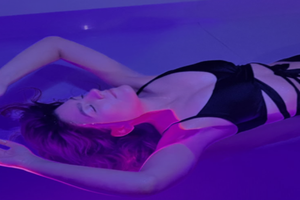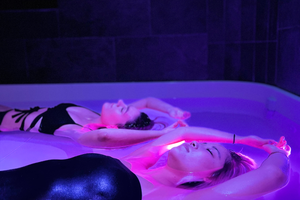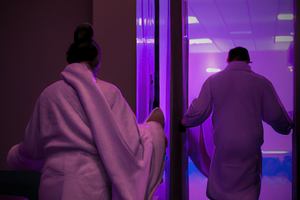"Floating together in silence and darkness, we felt a sense of closeness and calm. It was a great way to unwind and bond, without distractions."
Sensory deprivation float tanks, often simply referred to as sensory deprivation tanks or sensory deprivation pods, offer a unique experience aimed at reducing sensory input to the brain. This practice, also known as float therapy, involves floating in a shallow pool or tank filled with highly saturated Epsom salt water, allowing the individual to float effortlessly atop the water's surface. The sensory deprivation chamber is designed to block out all external stimuli, including light and sound, facilitating a state of deep relaxation and meditation. Discover the science behind sensory deprivation and its benefits in this article by Psychology Today.
How Sensory Deprivation Works? (Light, Sound, Gravity, Touch)
Inside the float tank, it’s completely dark and quiet. The water is heated to match your skin temperature, around 35°C (95°F), so it feels like you’re not even in water. This helps your body stop feeling most physical sensations.
The tank also contains a lot of Epsom salt, which makes the water very dense. This lets your body float without effort, almost like being in outer space. Without gravity pulling you down, your body and brain get a break. Some scientists say even a small part of the brain that helps us balance takes a rest during floatation. This rest gives your mind a chance to recharge.
Why Epsom Salt and Water Temperature Matter?
Epsom salt is made of magnesium and sulfate. It isn’t the same as table salt. When it’s mixed in water, your skin can absorb the magnesium. This mineral helps your muscles relax, eases stress, and helps your body make energy. The combination of Epsom salt and warm water makes it easier for your body to float and feel safe, which adds to the relaxing effect.
When your body is floating and fully supported, you stop feeling things like pressure or touch. This lets your brain fully relax, which can help your body absorb more magnesium. In this way, your physical comfort helps your mind relax, and that mental relaxation improves your body’s response. All the parts of the experience work together.
Floatation therapy is more than just taking a break. Many people say it helps them feel like they are hitting a reset button. Without distractions like light, noise, and constant thinking, the brain can slow down and reorganize. You might find new solutions to problems, feel clearer, and be more emotionally refreshed afterward. It’s not just relaxing, it can help your mind and body work better too. A similar effect is seen in Dry Flotation Therapy, where users lie on a heated, water-filled membrane without getting wet, offering many of the same calming benefits without full immersion.
What are the Benefits of Floatation Therapy?
Floatation therapy has many benefits that help your body, mind, and brain. These benefits work together to make you feel better overall.
Physical Health Benefits
Pain Relief: The salty water in a float tank helps your body float easily, taking pressure off your joints and muscles. This can help people who have long-term pain, like arthritis or back pain, feel more comfortable. Relaxing in the tank helps muscles loosen up and lowers pain caused by stress.
Muscle Recovery and Sports Performance: Floatation therapy is great for people who play sports or work out a lot. Floating helps muscles recover faster by lowering soreness and getting rid of waste like lactic acid. The salty water also helps blood flow better, which brings more oxygen and nutrients to tired muscles. This can help athletes feel better and get back to their activities sooner.
Better Sleep: Because floatation therapy helps you relax deeply, it can also help you sleep better. Some studies have found that it helps people who have trouble falling asleep. Floating helps your body reset its natural sleep rhythm and may help it produce more melatonin, a chemical that helps you sleep. Doing float sessions regularly can help you sleep more deeply and feel more refreshed. Some float centers also offer Light & Sound Floating Therapy, which uses calming visual and auditory elements during the session to further enhance relaxation and support sleep improvement.
Mental and Emotional Well-being
Lower Stress and Anxiety: When you're in the float tank, there are no lights or sounds. This quiet environment lowers the stress hormone called cortisol. People who use floatation therapy often feel less worried and more calm. Even people with anxiety disorders have seen improvements that last for weeks or months.
Better Mood and Clearer Thinking: Floating helps your brain take a break and feel more relaxed. This can make you feel happier and help you think more clearly. Some people feel more peaceful and better able to handle challenges after floating. Your body also releases feel-good chemicals like endorphins and serotonin while you're in the tank.
Mindfulness and Relaxation: The float tank is a quiet, peaceful place where you can be alone with your thoughts. This helps people slow down, relax, and reflect. It's a great way to take a break from the busy world and focus on your inner self.
Brain Benefits and Thinking Skills
More Creativity and Focus: Many people say they come up with new ideas or think more clearly after floating. When your brain is very relaxed, it enters a special state called theta waves, which is great for creativity. The quiet space in the tank helps your brain focus without distractions.
Better Problem-Solving: Floating gives your brain time to think without interruptions. This helps you come up with new solutions and see problems in a new way.
All these benefits connect with each other. For example, when your mind is less stressed, your body feels better. And when your body feels better, your mind can be more relaxed too. This creates a cycle where each good effect supports the others, helping you feel better in every way. That’s why floatation therapy can help with problems that involve both the mind and the body.
One float session can help, but doing it regularly makes the biggest difference. People often say that regular float sessions help them manage stress, pain, focus, and sleep better over time. The calm feeling you get in the tank can last even after the session is over. If you float often, your brain may even change in ways that help you stay more relaxed and focused every day, just like what happens with regular yoga or meditation. So, if you want long-lasting results, it’s a good idea to make floatation therapy part of your routine.
Safety, Risks, and Warnings: Who Can and Can’t Use Float Tanks?
Floatation therapy is usually safe for healthy people, but there are certain times when it might not be the best choice. If you’re unsure whether it’s right for you, it’s a good idea to talk with a wellness expert first. Feel free to call 212-600-0220 for guidance tailored to your needs.
General Safety
Float tanks are built to be safe. The water has a lot of Epsom salt, which makes it super easy to float. People float on their backs, and their heads stay mostly above water (you can wear earplugs if you like). Because you float so easily, it’s very unlikely someone would drown.
The salt in the water won’t hurt your skin. Epsom salts can help make your skin feel soft and smooth. Float centers also keep the water very clean. After every session, the water usually goes through a strong filter and gets cleaned with UV light and disinfectants.
You can leave the float tank anytime you want. Some people might feel a little dizzy or sensitive to lights and sounds right after their first session, but this usually goes away quickly.
Who Should NOT Use Float Therapy?
Some people should avoid float tanks for safety reasons:
- If you are drunk, high, or taking meds that make you sleepy, don’t use the float tank. You might fall asleep and not float safely.
- If you have cuts, open wounds, new tattoos, or piercings, wait until they are fully healed. The salt will sting and could slow healing.
- If you are sick with something contagious like a stomach bug, don’t float until at least two weeks after you feel better.
- If you have seizures, serious mental health conditions (like Schizophrenia), or uncontrolled epilepsy, floating might not be safe.
- Most float centers only allow people 16 and older. Some allow teens with parent permission. Kids under 13 may need a parent in the room.
- If you’ve just dyed your hair, wait at least a week or until water runs clear when you shower. The salt might mess up your hair color.
- If you’re getting cancer treatments like chemo or radiation, have kidney problems, or low blood pressure, it’s important to check first, call 212-600-0220 to talk with a wellness professional who can help you decide if floating is right for you.
- If you’re on your period, make sure you follow public pool rules, or reschedule your session if you’re not sure.
Check First If...
Some people need to check with their doctor before trying floatation therapy:
- Pregnant women should check before floating. Some say it’s safe after the first trimester and helps with body pain and bonding with the baby, but others suggest being cautious.
- If you have a heart condition or asthma, are sensitive to things like chlorine or magnesium, or have spine or back problems, it’s best to get personalized guidance.
- If you tend to get ear infections or you’re taking any medications, there might be specific things to watch for.
For any of these situations, you can call 212-600-0220 to speak with a wellness specialist and find out if floating is right for you.
What About Claustrophobia?
Some people worry they’ll feel trapped in the float tank. But many people with claustrophobia say they’re fine. Most float centers offer larger float rooms or let you leave the lid open and the lights on. This helps you feel more comfortable.
Why Pre-Screening Matters?
It’s important to check your health and ask questions before floating. Not everyone is the same, and float centers should help you figure out if floating is right for you. They may even ask you to fill out a health form. Staying safe isn’t just the center’s job; it’s also up to you to make a smart, informed choice. If you’re unsure, contact us to get personalized advice from a wellness professional.
Myths About Sensory Deprivation Float Tanks
Several myths surround sensory deprivation float tanks, including concerns about claustrophobia, safety, and hygiene. However, what is a sensory deprivation tank truly about? It's a carefully designed, safe, and hygienic environment that offers a personal sanctuary for relaxation and self-exploration, debunking common misconceptions with scientifically backed practices and stringent health standards. At FloLo Holistic, our tanks are in an open space, eliminating the fear of claustrophobia. A great article with all the facts about sensory deprivation can be found here.
Enhancing Wellness Through Float Tank Therapy
Float tank therapy is a complementary wellness practice that synergizes well with meditation, yoga, and mindfulness techniques. It amplifies the benefits of these practices, providing a physical and mental space where one can deepen their meditative state, enhance mindfulness, and cultivate a greater sense of well-being. What does a sensory deprivation tank do? It offers a unique environment that supports and enhances the journey towards holistic health. For insights into how float therapy complements meditation, visit here.
Our Process for Floating in a Sensory Deprivation Tank
FloLo Holistic offers a unique experience for those interested in floating in a sensory deprivation tank. Our tailored sessions ensure comfort, safety, and the maximum therapeutic benefit. Experience our Sensory Deprivation Water Float, designed to provide total body relaxation and inner peace. Whether you're seeking sensory deprivation therapy for the first time or are a seasoned floater, our process is crafted to provide you with a transformative experience.
Future of Sensory Deprivation Float Tanks
The future of sensory deprivation float tanks is bright, with ongoing research uncovering new benefits and applications for this versatile therapy. From enhancing athletic performance and creativity to supporting mental health and chronic pain management, sensory deprivation float therapy continues to gain popularity as a valuable component of modern wellness practices. As we explore and understand more about the benefits of sensory deprivation tanks, the potential for personal and societal wellness grows exponentially. Stay updated with the latest research and developments at ScienceDirect.
Zero Gravity Dry Float and Light & Sound Therapy Float
Like Sensory Deprivation Water Float, our Zero Gravity Dry Float offers a similar feeling of weightlessness, promoting relaxation and alleviating physical tension without the need for water immersion. In contrast, our Light & Sound Therapy Float offers a dry float experience but includes light and sound to stimulate the senses.
Frequently Asked Questions
1. What does a sensory deprivation tank do?
A sensory deprivation tank in NYC, also known as a sensory deprivation pod, is designed to create an environment free of sensory input. This unique setting allows the mind to drift into a deep state of relaxation, promoting stress relief, creativity, and self-reflection. By floating in a sensory deprivation tank filled with Epsom salt-saturated water, the body achieves a state of weightlessness, reducing physical strain on the muscles and joints, and encouraging mental tranquility.
2. Can children or teenagers use sensory deprivation float tanks?
While sensory deprivation float tanks offer numerous benefits, their suitability for children and teenagers depends on individual maturity and comfort levels. It's essential to consult with a healthcare professional and the float center to ensure it's a safe and beneficial experience for younger users. Learn about our Sensory Deprivation Water Floatation session, an ultimate relaxation experience, here.
3. How often should I schedule sensory deprivation float tank sessions for optimal benefits?
The frequency of sensory deprivation float tank sessions varies depending on individual needs and wellness goals. Many find that floating once a week or bi-weekly offers significant benefits, including reduced stress, improved sleep, and enhanced mental clarity. Consistency is key to maximizing the therapy's benefits. Explore our various floatation therapy options here to find the perfect fit for your schedule. Floating also goes great with our Cold Water Plunge pool.
4. What is sensory deprivation?
Sensory deprivation near me involves reducing or eliminating stimuli from one's environment to allow the brain to enter a state of deep relaxation. This practice, facilitated by sensory deprivation tanks, helps to calm the mind, relieve stress, and promote a meditative state of consciousness. Learn more about sensory deprivation benefits in this article by the Cleveland Clinic.
5. Is sensory deprivation float tank therapy suitable for everyone?
Sensory deprivation float tank therapy is beneficial for most people, offering a unique way to relax and rejuvenate. However, individuals with certain medical conditions or those who are pregnant should consult a healthcare professional before trying float therapy. Discover our Zero Gravity Dry Float experience, which provides a profound relaxation akin to napping in outer space without getting wet.
6. How long does a typical float tank session last?
A typical float tank session lasts between 60 to 90 minutes, providing ample time for the body and mind to relax deeply. However, session lengths can vary based on individual preference and the specific service offered. To float with a friend or loved one, experience the tranquility of our Couples Sensory Deprivation Water Float.
7. Are there any side effects of Sensory Deprivation Float Tank Therapies?
Most individuals find sensory deprivation float tank therapy to be a safe and beneficial wellness practice. However, some may experience disorientation or mild nausea initially, which typically subsides with regular sessions. It's important to follow all provided instructions and communicate any concerns with our staff. Learn more about preparing for a float session here.
8. What exactly is a sensory deprivation float tank?
A sensory deprivation float tank is a specially designed tank or shallow pool filled with a solution of water and Epsom salt, allowing individuals to float effortlessly. The tank or room is engineered to block out external light and sound, creating a serene environment for deep relaxation and meditation. Explore the unique experience of our Light & Sound Float that combines light and sound therapy with floating.
9. What types/packages do we offer for sensory deprivation floats?
FloLo Holistic offers a variety of float therapy options to suit different needs and preferences, including:
- Sensory Deprivation Water Float: A classic float experience for deep relaxation.
- Zero Gravity Dry Float: Experience weightlessness without getting wet.
- Couples Sensory Deprivation Water Float: Enjoy the float with a friend or partner.
- Couples Bathhouse Combo: Share a float experience and cold plunge with a partner.
- Light & Sound Therapy Float: A unique combination of sound and light therapy with floating.







